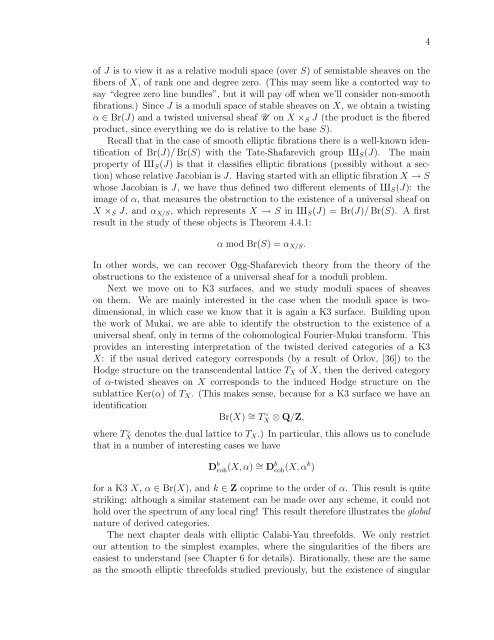derived categories of twisted sheaves on calabi-yau manifolds
derived categories of twisted sheaves on calabi-yau manifolds
derived categories of twisted sheaves on calabi-yau manifolds
You also want an ePaper? Increase the reach of your titles
YUMPU automatically turns print PDFs into web optimized ePapers that Google loves.
<str<strong>on</strong>g>of</str<strong>on</strong>g> J is to view it as a relative moduli space (over S) <str<strong>on</strong>g>of</str<strong>on</strong>g> semistable <str<strong>on</strong>g>sheaves</str<strong>on</strong>g> <strong>on</strong> the<br />
fibers <str<strong>on</strong>g>of</str<strong>on</strong>g> X, <str<strong>on</strong>g>of</str<strong>on</strong>g> rank <strong>on</strong>e and degree zero. (This may seem like a c<strong>on</strong>torted way to<br />
say “degree zero line bundles”, but it will pay <str<strong>on</strong>g>of</str<strong>on</strong>g>f when we’ll c<strong>on</strong>sider n<strong>on</strong>-smooth<br />
fibrati<strong>on</strong>s.) Since J is a moduli space <str<strong>on</strong>g>of</str<strong>on</strong>g> stable <str<strong>on</strong>g>sheaves</str<strong>on</strong>g> <strong>on</strong> X, we obtain a twisting<br />
α ∈ Br(J) and a <str<strong>on</strong>g>twisted</str<strong>on</strong>g> universal sheaf U <strong>on</strong> X ×S J (the product is the fibered<br />
product, since everything we do is relative to the base S).<br />
Recall that in the case <str<strong>on</strong>g>of</str<strong>on</strong>g> smooth elliptic fibrati<strong>on</strong>s there is a well-known identificati<strong>on</strong><br />
<str<strong>on</strong>g>of</str<strong>on</strong>g> Br(J)/ Br(S) with the Tate-Shafarevich group XS(J). The main<br />
property <str<strong>on</strong>g>of</str<strong>on</strong>g> XS(J) is that it classifies elliptic fibrati<strong>on</strong>s (possibly without a secti<strong>on</strong>)<br />
whose relative Jacobian is J. Having started with an elliptic fibrati<strong>on</strong> X → S<br />
whose Jacobian is J, we have thus defined two different elements <str<strong>on</strong>g>of</str<strong>on</strong>g> XS(J): the<br />
image <str<strong>on</strong>g>of</str<strong>on</strong>g> α, that measures the obstructi<strong>on</strong> to the existence <str<strong>on</strong>g>of</str<strong>on</strong>g> a universal sheaf <strong>on</strong><br />
X ×S J, and αX/S, which represents X → S in XS(J) = Br(J)/ Br(S). A first<br />
result in the study <str<strong>on</strong>g>of</str<strong>on</strong>g> these objects is Theorem 4.4.1:<br />
α mod Br(S) = αX/S.<br />
In other words, we can recover Ogg-Shafarevich theory from the theory <str<strong>on</strong>g>of</str<strong>on</strong>g> the<br />
obstructi<strong>on</strong>s to the existence <str<strong>on</strong>g>of</str<strong>on</strong>g> a universal sheaf for a moduli problem.<br />
Next we move <strong>on</strong> to K3 surfaces, and we study moduli spaces <str<strong>on</strong>g>of</str<strong>on</strong>g> <str<strong>on</strong>g>sheaves</str<strong>on</strong>g><br />
<strong>on</strong> them. We are mainly interested in the case when the moduli space is twodimensi<strong>on</strong>al,<br />
in which case we know that it is again a K3 surface. Building up<strong>on</strong><br />
the work <str<strong>on</strong>g>of</str<strong>on</strong>g> Mukai, we are able to identify the obstructi<strong>on</strong> to the existence <str<strong>on</strong>g>of</str<strong>on</strong>g> a<br />
universal sheaf, <strong>on</strong>ly in terms <str<strong>on</strong>g>of</str<strong>on</strong>g> the cohomological Fourier-Mukai transform. This<br />
provides an interesting interpretati<strong>on</strong> <str<strong>on</strong>g>of</str<strong>on</strong>g> the <str<strong>on</strong>g>twisted</str<strong>on</strong>g> <str<strong>on</strong>g>derived</str<strong>on</strong>g> <str<strong>on</strong>g>categories</str<strong>on</strong>g> <str<strong>on</strong>g>of</str<strong>on</strong>g> a K3<br />
X: if the usual <str<strong>on</strong>g>derived</str<strong>on</strong>g> category corresp<strong>on</strong>ds (by a result <str<strong>on</strong>g>of</str<strong>on</strong>g> Orlov, [36]) to the<br />
Hodge structure <strong>on</strong> the transcendental lattice TX <str<strong>on</strong>g>of</str<strong>on</strong>g> X, then the <str<strong>on</strong>g>derived</str<strong>on</strong>g> category<br />
<str<strong>on</strong>g>of</str<strong>on</strong>g> α-<str<strong>on</strong>g>twisted</str<strong>on</strong>g> <str<strong>on</strong>g>sheaves</str<strong>on</strong>g> <strong>on</strong> X corresp<strong>on</strong>ds to the induced Hodge structure <strong>on</strong> the<br />
sublattice Ker(α) <str<strong>on</strong>g>of</str<strong>on</strong>g> TX. (This makes sense, because for a K3 surface we have an<br />
identificati<strong>on</strong><br />
Br(X) ∼ = T ∨<br />
X ⊗ Q/Z,<br />
where T ∨<br />
X denotes the dual lattice to TX.) In particular, this allows us to c<strong>on</strong>clude<br />
that in a number <str<strong>on</strong>g>of</str<strong>on</strong>g> interesting cases we have<br />
D b coh(X, α) ∼ = D b coh(X, α k )<br />
for a K3 X, α ∈ Br(X), and k ∈ Z coprime to the order <str<strong>on</strong>g>of</str<strong>on</strong>g> α. This result is quite<br />
striking: although a similar statement can be made over any scheme, it could not<br />
hold over the spectrum <str<strong>on</strong>g>of</str<strong>on</strong>g> any local ring! This result therefore illustrates the global<br />
nature <str<strong>on</strong>g>of</str<strong>on</strong>g> <str<strong>on</strong>g>derived</str<strong>on</strong>g> <str<strong>on</strong>g>categories</str<strong>on</strong>g>.<br />
The next chapter deals with elliptic Calabi-Yau threefolds. We <strong>on</strong>ly restrict<br />
our attenti<strong>on</strong> to the simplest examples, where the singularities <str<strong>on</strong>g>of</str<strong>on</strong>g> the fibers are<br />
easiest to understand (see Chapter 6 for details). Birati<strong>on</strong>ally, these are the same<br />
as the smooth elliptic threefolds studied previously, but the existence <str<strong>on</strong>g>of</str<strong>on</strong>g> singular<br />
4
















